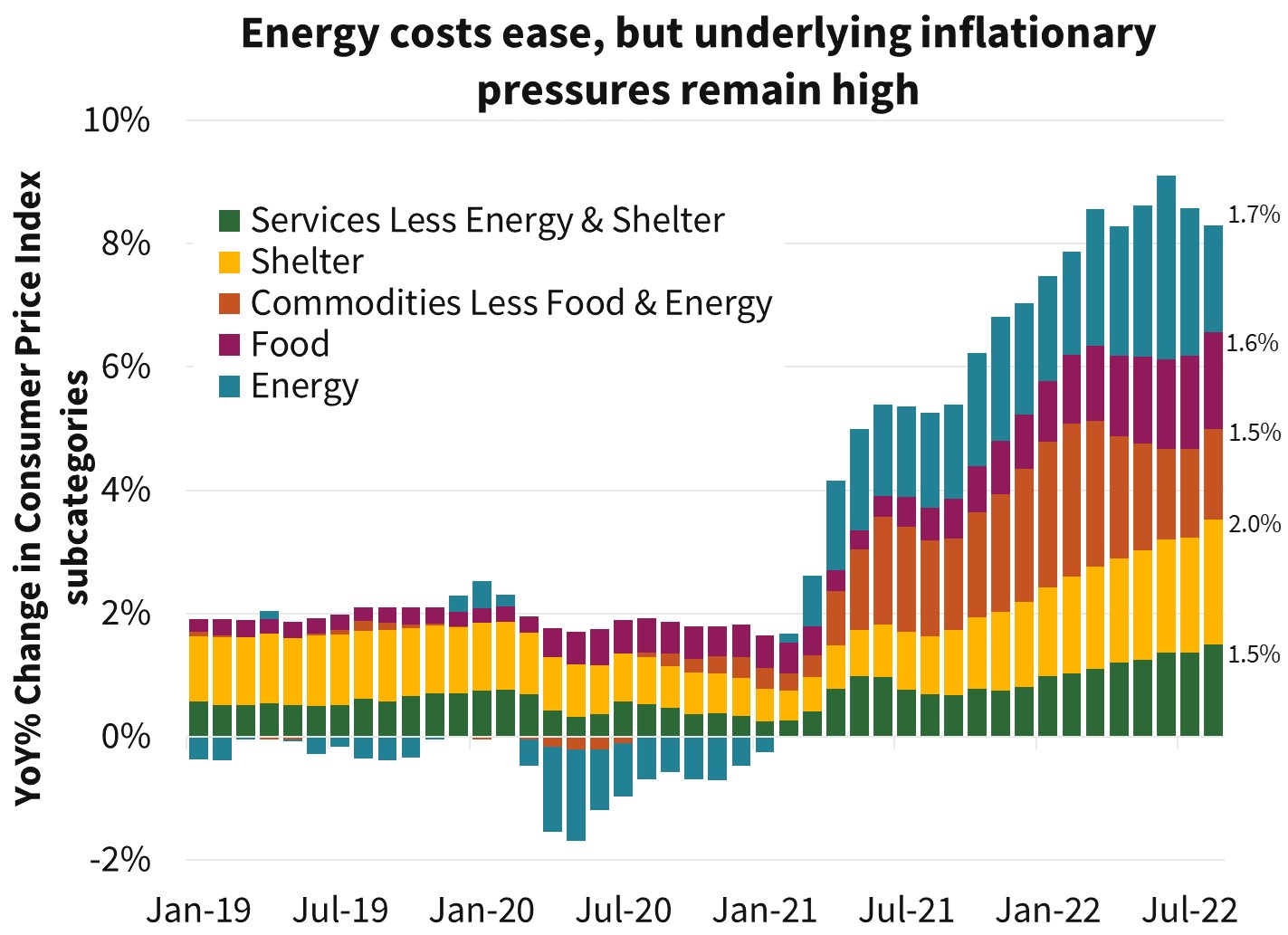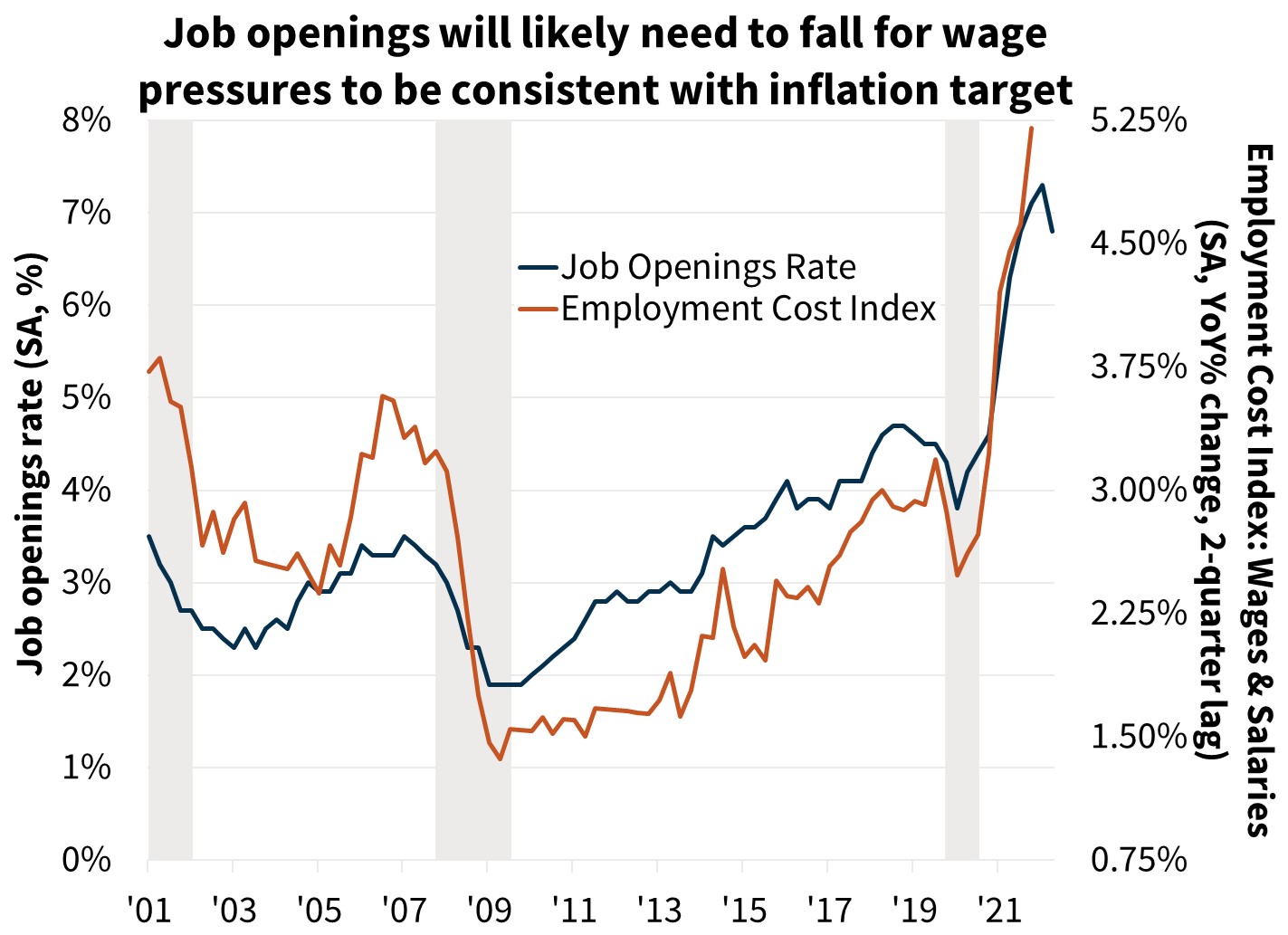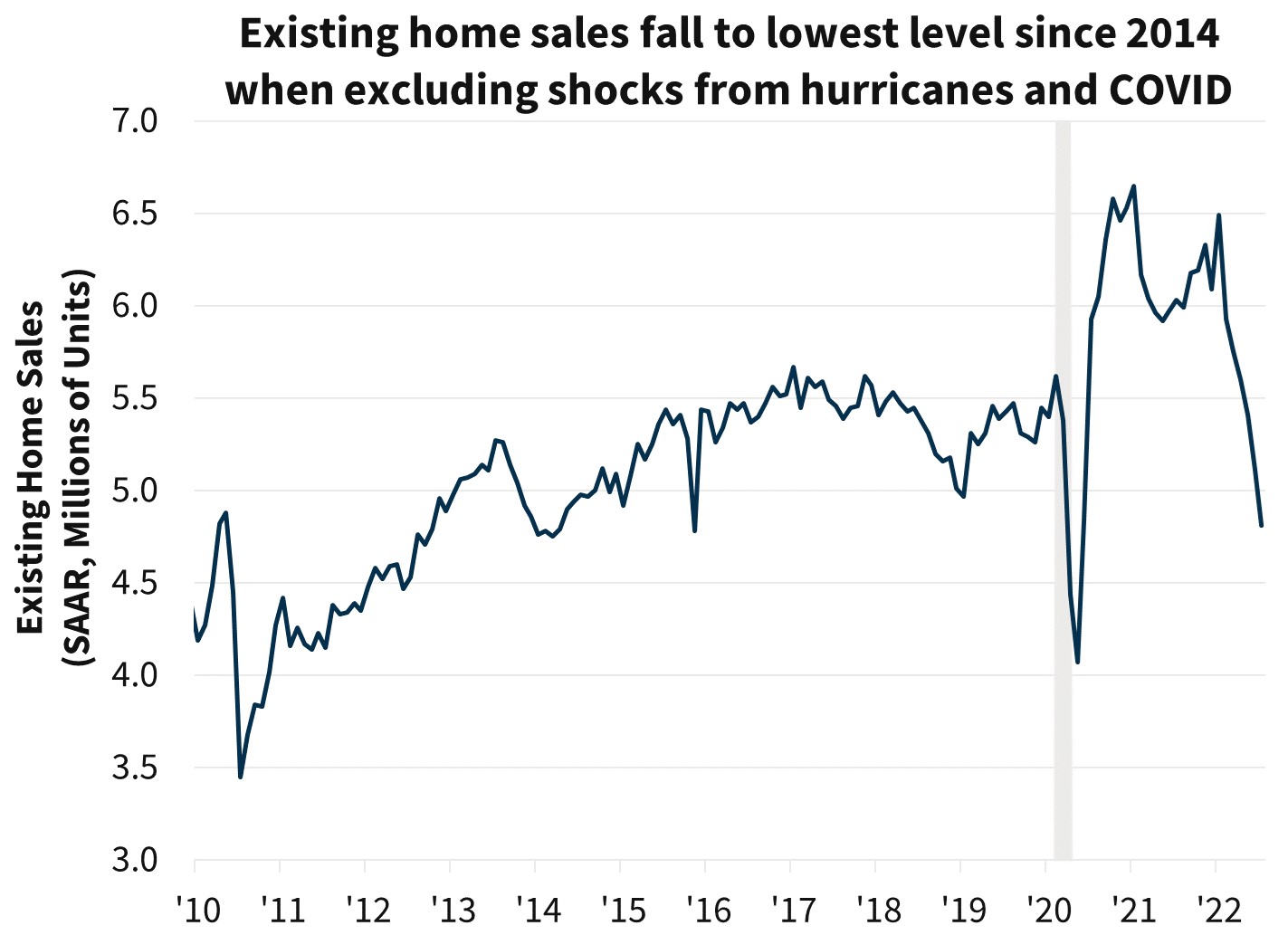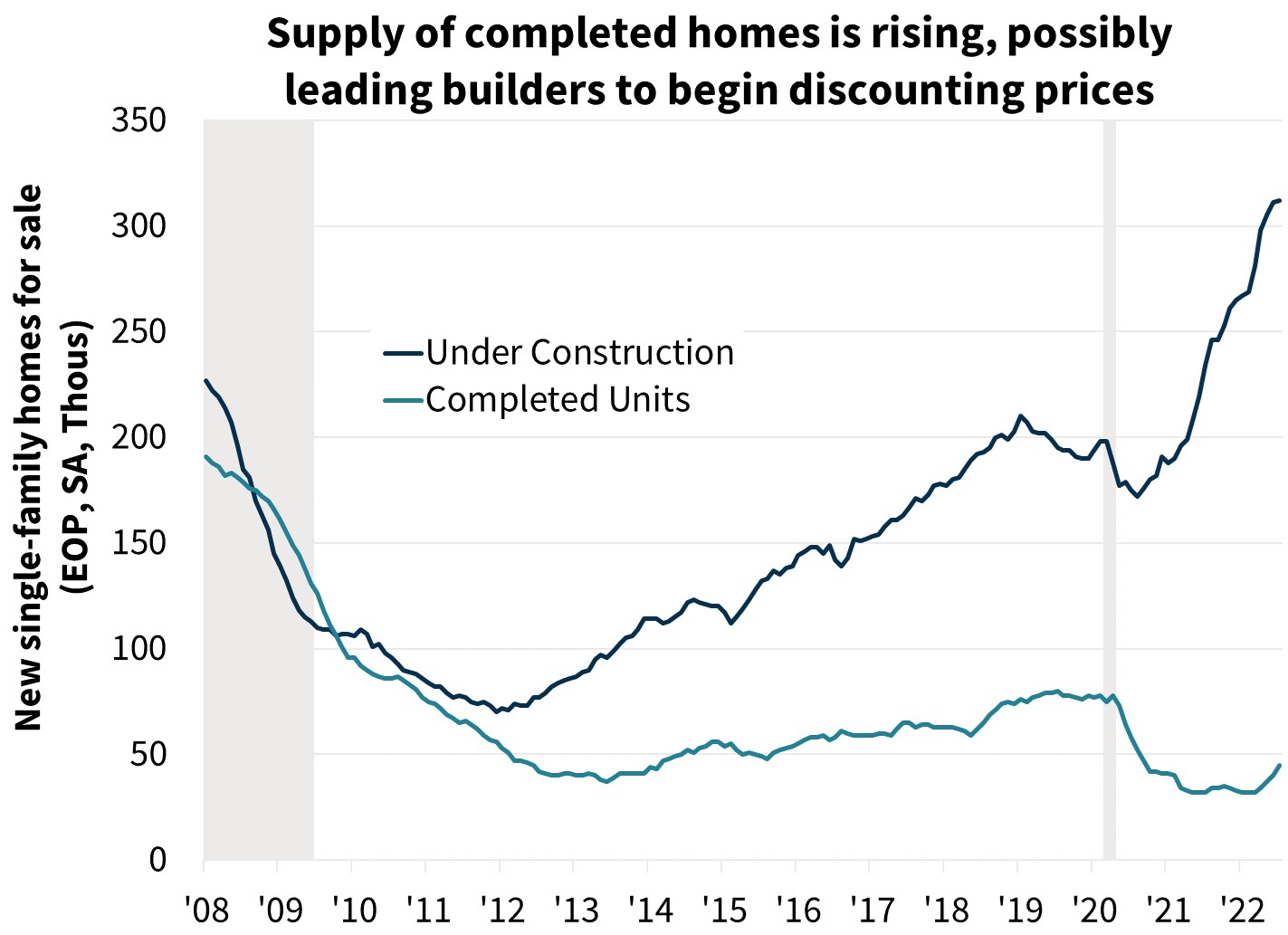Housing and Interest Rates Continue to Suggest Recession Likely in 2023
We project 2022 real gross domestic product (GDP) to be flat at 0.0 percent growth and to decline 0.5 percent in 2023, both on a Q4/Q4 basis. In the near term, we expect modest economic growth over the second half of the year as large swings in net exports that previously dragged in the first half should boost GDP over the latter part of the year. However, in light of expected continuing tightening of monetary policy and global economic weakness, we expect a further slowing in housing activity and sluggish consumer spending and business investment growth. We continue to expect a moderate recession to occur in 2023 along with a weakening of the labor market.
Headline inflation has moderated over the past two months; however, this is largely due to a significant decline in gasoline prices. Core inflation, along with food prices, continue to remain well above the Federal Reserve’s target. Following the completion of our forecast, the August release of the Consumer Price Index (CPI) showed core prices rising 0.6 percent over the month and 6.3 percent on an annual basis, an acceleration of four-tenths from July. Given this, we expect the Federal Reserve to continue its course of raising short-term interest rates and anticipate an additional 75 basis point hike at its September meeting, though markets are partially pricing in the possibility of a full 100 basis point increase. Our baseline forecast is for the Fed Funds rate to top out at the 3.50-3.75 percent range in early 2023, but we see upside risk to this terminal rate.
We lowered our 2022 forecast for total home sales slightly to 5.71 million units, a 17.2 percent decline from 2021, down from our previous forecast of a 16.2 percent drop. The change was disproportionally due to a lower expectation for new homes sales, but existing home sales were downgraded as well, in large part due to mortgage rates again moving higher (exceeding 6.0 percent for the first time since 2008, according to the most recent Freddie Mac survey). Our total home sales outlook for 2023 was revised downward from 5.18 million to 4.98 million units. Given changes to our outlook for both home sales and mortgage rates, along with benchmarking to latest Home Mortgage Disclosure Act (HMDA) data, we have slightly lowered our forecast for 2022 mortgage originations to $2.44 trillion (previously $2.47 trillion) and our 2023 mortgage originations forecast to $2.17 trillion (previously $2.29 trillion).
Inflation Dynamics Are Shifting
Topline inflation drivers continue to shift away from rising goods and commodities prices and toward services. While we believe headline inflation has likely peaked, strong rent growth and a tight labor market are leading to a more persistent inflationary trend, which historically has been difficult to contain without a general economic contraction.
A steep drop in gasoline prices of 10.6 percent kept the August headline CPI modest for the second consecutive month, rising only 0.1 percent, in line with our expectations. On an annual basis, headline CPI decelerated further to 8.3 percent, down from the recent peak of 9.1 percent in June. However, almost all other major categories rose over the month, with the core CPI rising 0.6 percent, reaccelerating to an annual rate of 6.3 percent. The strength in non-energy goods prices was somewhat at odds with other indicators, such as business surveys showing a declining share of firms raising prices. The stronger dollar exchange rate, driven in part by weakening economic growth abroad, is also putting downward pressure on import prices, which fell 1 percent in August. Going forward, we expect softening in goods price inflation, which was supported by the August Producer Price Index (PPI) showing softer goods price inflation.
However, shelter inflation, which rose at a rapid 0.7 percent over the month (the largest monthly increase since 1991) is likely to remain strong at least through mid-2023. As we have discussed previously, there is a considerable time lag between moves in house prices, rents, and changes in the CPI measure of shelter costs. More worrisome, however, is acceleration in non-energy, non-shelter services inflation. While such services only contributed about 1.5 percentage points to annual headline inflation in August, that share has grown from 1.0 percentage points in January and is approximately triple its average share of annual inflation in 2019 of 0.5 percentage points, reflecting the possibility that a tight labor market could lead to a difficult-to-reverse wage-price spiral dynamic.
Upside Risk on Monetary Policy Tightening
While payroll employment growth decelerated in August, it remained at a robust pace of 315,000 over the month. Continued strong employment gains are supportive of consumer spending and near-term economic growth. However, with a growing share of inflation being driven via labor market tightness, continued strength likely increases the chance of greater or longer-lasting monetary policy tightening. The Fed has previously mentioned explicitly the need for job openings to decline for wage growth to soften to a level consistent with a 2-percent inflation target.
From the Fed’s theoretical viewpoint, for labor market inflationary pressures to decelerate, the unemployment rate needs to exceed the level of the Non-Accelerating Inflation Rate of Unemployment (NAIRU), currently estimated by the Congressional Budget Office to be 4.5 percent. The unemployment rate in August was 3.7 percent. Chairman Powell alluded to this in August when he stated that “some pain” would be required to achieve price stability. A further complicating factor is a potential rebound in consumer confidence caused by a pullback in gasoline prices and additional discretionary income. While to date core retail sales have remained relatively subdued, if weaker gasoline prices bolstered consumer demand in other categories, then tighter monetary policy may be required (all else equal) to cool demand sufficiently.
Following the latest CPI report indicating growing service sector inflation and ongoing goods inflation, financial markets responded swiftly, and Treasury yields jumped. Even considering Fed rate hikes to date, the current policy stance is still, arguably, near neutral, meaning a rate that is neither stimulative nor contractionary to economic activity. We believe market expectations are beginning to take further into account the possibility that the Fed will have to raise its short-term rate well above neutral and perhaps maintain it for some time in order to induce sufficient labor market softening to achieve price stability. The ten-year Treasury yield closed at 3.45 percent on September 15, up about 80 basis points since the end of July. Meanwhile, the one-year Treasury yield closed at 4.0 percent, the highest since October 2007.
Home Sales Still Slowing on Higher Mortgage Rates
Existing home sales fell 5.9 percent in July to an annualized pace of 4.81 million, in line with our expectations. On an annual basis, sales were down 20.2 percent. With the exception of the initial COVID shutdowns in early 2020 and hurricane-related disruptions in 2015, this was the slowest pace of sales since 2014. Mortgage application data point to further sales declines in the near term, and with mortgage rates rising again, we have downwardly revised our existing home sales outlook through 2023. We now project 2022 total year existing sales to decline 16.5 percent from 2021, followed by a further decline of 13.3 percent in 2023. We will release our quarterly forecast update of the Fannie Mae Home Price Index in October.
New home sales and construction continue to come in weaker than anticipated. New home sales fell 12.6 percent in July and were down 32.3 percent from a year prior. The temporary pull back in mortgage rates last month may lead to some stabilization in the August new home sales number, but we expect further softening moving forward. At the current sales pace, the months’ supply of new homes on the market was 10.9 in July, up from 9.2 in June. This was the highest level since 2009. To this point, homebuilders do not appear to be offering incentives sufficient to move growing inventories, however, many publicly traded homebuilders continued to report historically elevated gross margins through the second quarter, suggesting room for greater discounting in the future. Homebuilders may have been reluctant to do so until recently as supply chain bottlenecks and labor shortages have resulted in an elevated share of homes for sale still being under construction compared to the historical norm. Currently, comparatively few finished homes are on the market, which may limit the need for builders to price more aggressively. However, over the past couple months, this number has begun to move upward, suggesting homebuilders may soon offer greater price concessions to drive sales.
Redfin reports that, for the first time since March 2021, the average sales price of an existing home fell below the average asking price. While housing inventories remain tight, the months’ supply of inventory is starting to rise. In August, the months’ supply for existing single-family homes was 3.3 at the current sales pace, up from 1.6 at the start of the year. As a ratio of sales, inventories are now approaching pre-COVID levels even if the absolute number of listings remains significantly lower.
Multifamily housing construction continues to be strong. However, we revised downward our forecast for multifamily starts in 2023, due to a higher interest rate outlook. We expect activity will slow in 2023 along with a slowing economy, but we expect demand for rental units to remain comparatively strong. As single-family home purchase affordability reaches lows not seen since 2006, many households will likely remain in a rental unit longer than they otherwise would.
Mortgage Originations
This month, we updated our historical estimate of 2021 single-family mortgage originations as a result of our annual benchmarking to the latest HMDA data. This resulted in minor upward revisions to estimated 2021 total origination volumes, with our 2021 estimate now at $4.57 trillion, about $101 billion higher that our prior estimate. Purchase and refinance volumes for 2021 are now estimated to be $1.9 trillion and $2.7 trillion, representing upward revisions of $37 billion and $64 billion, respectively.
Our forecast for 2022 purchase volumes remains at $1.7 trillion, essentially unchanged from last month. We now expect purchase volumes to fall about 1.5 percent in 2023 to just under $1.7 trillion, a downward revision of $17 billion from last month’s forecast, driven by downward revisions to our forecast for home sales.
In the refinance market, higher mortgage rates have significantly lowered the expected market size for 2022 and beyond. We now expect 2022 volumes to total $731 billion, $38 billion lower than last month’s forecast. We expect refinance volume to decrease further in 2023 to reach $490 billion, down $102 billion from last month’s forecast.
Economic & Strategic Research (ESR) Group
September15, 2022
For a snapshot of macroeconomic and housing data between the monthly forecasts, please read ESR’s Economic and Housing Weekly Notes.
Data sources for charts: Bureau of Labor Statistics, National Association of REALTORS®, Census Bureau.
Opinions, analyses, estimates, forecasts and other views of Fannie Mae's Economic & Strategic Research (ESR) Group included in these materials should not be construed as indicating Fannie Mae's business prospects or expected results, are based on a number of assumptions, and are subject to change without notice. How this information affects Fannie Mae will depend on many factors. Although the ESR group bases its opinions, analyses, estimates, forecasts and other views on information it considers reliable, it does not guarantee that the information provided in these materials is accurate, current or suitable for any particular purpose. Changes in the assumptions or the information underlying these views could produce materially different results. The analyses, opinions, estimates, forecasts and other views published by the ESR group represent the views of that group as of the date indicated and do not necessarily represent the views of Fannie Mae or its management.
ESR Macroeconomic Forecast Team
- Doug Duncan, SVP and Chief Economist
- Mark Palim, VP and Deputy Chief Economist
- Eric Brescia, Economics Manager
- Nick Embrey, Economist
- Nathaniel Drake, Economic Analyst
- Richard Goyette, Economic Analyst




